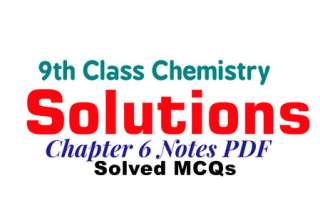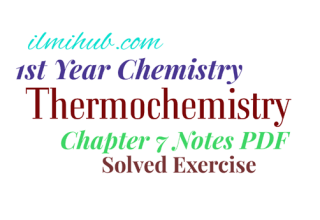In this post, I am sharing FSC 1st Year Chemistry Chapter 10 Short Questions PDF Notes for the students of FSC Part 1. The name of Intermediate Part 1 Chemistry Chapter 10 is Electrochemistry. So the students can download Electrochemistry Chapter Short Questions in PDF format from here. This file contains only 8 pages. These Chemistry Notes are for all the boards working under Punjab Board like Gujranwala Board, Lahore Board, Faisalabad Board, Multan Board, Rawalpindi Board, Sargodha Board, DG Kahn Board, and Sahiwal Board. Here are the complete 1st Year Chemistry Notes.
11th Class Chemistry Chapter 10 “Electrochemistry” Short Question PDF Download
Difference between Oxidation and Reduction
| Oxidation | Reduction |
| The addition of oxygen in a substance is called as oxidation | The addition of hydrogen in a substance is called as reduction |
| Removal of hydrogen form a substance is also called oxidation | Removal of oxygen from a substance is called reduction |
| Oxidation involves loss of electrons by a substance | Reduction involves gain of electron by a substance |
| There is an increase in oxidation number of the element | There is a decrease in the oxidation number of a n element |
Lead accumulator is a chargeable battery
“Those galvanic cells, whose electrode reactions can be reversed (by applying electric current) are rechargeable, and are called as secondary cells”
Lead accumulator is a rechargeable battery and it can be explained by the following reactions
Discharging;
During the process of discharging, a spontaneous redox reaction at the electrodes generate electricity. The reaction are given as
Anode: Pb(s) + SO4-2 ____________ PbSO4 + 2e– (Oxidation)
Cathode: PbO2 + SO4-2 + 4H+ + 2e– ___________ PbSO4 + 2H2O (reduction)
Recharging:
During the process of recharging, the anode and of external source are connected to the anode and the cathode respectively. The redox reactions at the respective electrodes are then reversed.
these reactions are summarized as follows.
Anode: PbSO4 + 2e– ___________ Pb(s) + SO4-2 (reduction)
Cathode : PbSO4 + 2H2O ____________ PbO2 + 4O+ + SO4-2 + 2e– (oxidation)
A porous plate or a salt bridge is not required in lead storage cell.
A porous plate or a salt bridge is used in those galvanic cells in which the electrodes are dipped in two different electrolyte solutions and we want to keep them separate.
In a lead storage battery both the electrode are dipped in the same electrolyte. Moreover, both the electrodes produced same products. So there is no chance of mixing the electrolyte or the electrode products. Therefore, salt bridge is not required in lead storage cell.
Relevant Notes
- 1st Year Chemistry Chapter 1 Short Questions Notes PDF
- 11th Chemistry Chapter 2 Short Questions Notes PDF
- Fsc Part 1 Chemistry Chapter 3 Short Questions Notes PDF
- 1st Year Chemistry Chapter 4 Short Questions Notes PDF
- 1st Year Chemistry Chapter 5 Short Questions Notes PDF
- 11th Chemistry Chapter 6 Short Questions Notes PDF
- FSC 1st Year Chapter 7 Short Questions Notes PDF
- 1st Year Chemistry Chapter 8 Short Questions Notes PDF
- FSC Part 1s Chemistry Chapter 9 Short Question Notes PDF





